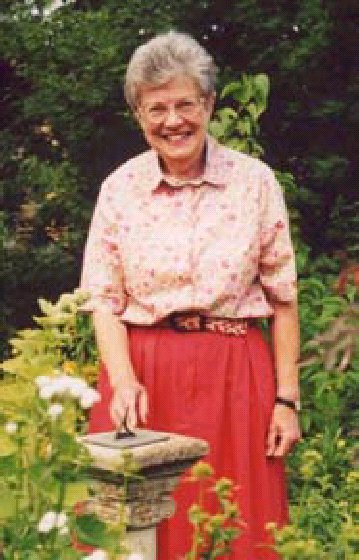 Our guide for a tour of dials in this old market town is Jill Wilson,
local historian and Member of the BSS Council, seen here with her own
Chipping Campden dial.
Our guide for a tour of dials in this old market town is Jill Wilson,
local historian and Member of the BSS Council, seen here with her own
Chipping Campden dial.
'I know of seven old vertical dials in Campden High Street. From a 19th
Century painting it seems that there were at least two more 150 years
ago. Beyond the High Street there are another four, not counting the scratch
dials on the church. All this is without counting the decorative 20th
Century garden dials. If anyone can suggest why such a tiny town was so
fixated on telling the time please let me know. I find it a puzzle.'
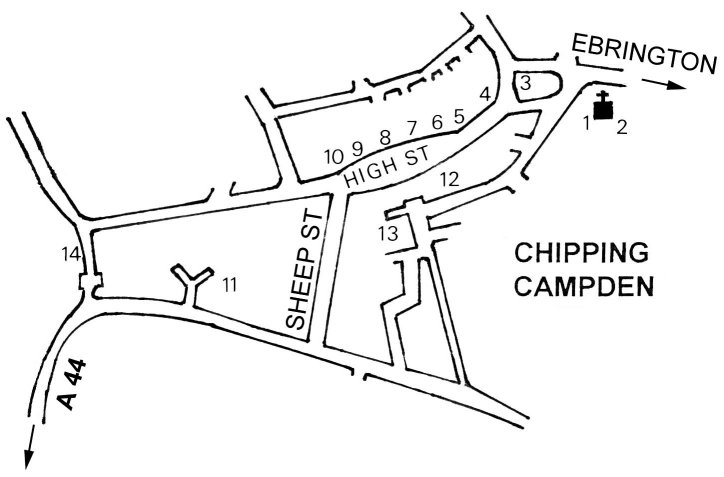 Numbers on the map are indicated in the text. NB You can click on any
of the images in this sundial trail to see a larger copy.
Numbers on the map are indicated in the text. NB You can click on any
of the images in this sundial trail to see a larger copy.
'Let's go on a Chipping Campden Sundial Safari - Chipping Campden is an
historic town - there's a Bronze Age axe, Roman roads and an alleged meeting
of Saxon Kings in AD 689. Cotswold wool brought prosperity to the town
in the 14th century and the Church of St James the Greater (1), where
we start, was partly rebuilt then.
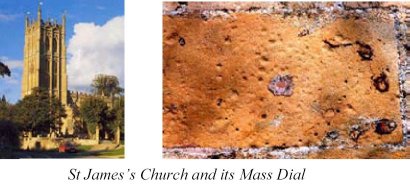 The south porch was added mid 14th century so the scratch dials must be
from 1350 or later. The 18th Century avenue of lime trees shade the dials
for most of the day. In the churchyard is a more recent dial, memorial
to Henrietta Bartleet (2), wife of Canon Samuel Edwin Bartleet, author
of many mottoes quoted in Mrs Gatty's 'Book of Sundials'.
The south porch was added mid 14th century so the scratch dials must be
from 1350 or later. The 18th Century avenue of lime trees shade the dials
for most of the day. In the churchyard is a more recent dial, memorial
to Henrietta Bartleet (2), wife of Canon Samuel Edwin Bartleet, author
of many mottoes quoted in Mrs Gatty's 'Book of Sundials'.
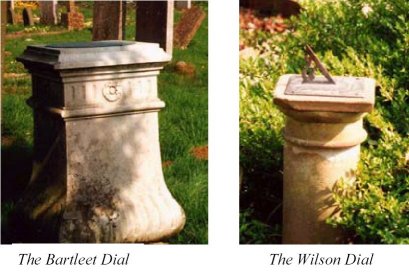 Unfortunately it has lost its gnomon at some stage. The Bartleet dial
was made by F. Barker & Son of Clerkenwell Road, London. We've just seen
one memorial, here's another. The Wilson Garden in Leasebourne was constructed
to commemorate Ernest Wilson, local born and an intrepid plant hunter.
The garden contains examples of plants he found in China, Japan, Tibet
and other distant places. Wilson's memorial dial (3) is a simple modern
dial.
Unfortunately it has lost its gnomon at some stage. The Bartleet dial
was made by F. Barker & Son of Clerkenwell Road, London. We've just seen
one memorial, here's another. The Wilson Garden in Leasebourne was constructed
to commemorate Ernest Wilson, local born and an intrepid plant hunter.
The garden contains examples of plants he found in China, Japan, Tibet
and other distant places. Wilson's memorial dial (3) is a simple modern
dial.
Moving to the High Street, William Grevel - a rich London wool merchant-lived
in the above magnificent house at the end of the 14th Century. It is perhaps
the oldest house in the High Street. We don't know if they had a dial
but the house (Grevel's House) has one today (4), dated 1815.
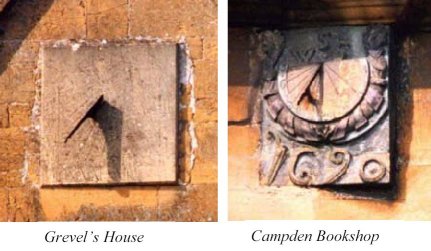 The dial on the Campden Bookshop (5) is dated 1690 and is angled out from
the wall allowing a later time in the afternoon to be shown than the other
dials which, owing to the curve of the street, face more or less south-east.
This bookshop dial was used to set the Town Hall clock but you cannot
actually see the Town Hall from here as the Market Hall is in the way.
The dial on the Campden Bookshop (5) is dated 1690 and is angled out from
the wall allowing a later time in the afternoon to be shown than the other
dials which, owing to the curve of the street, face more or less south-east.
This bookshop dial was used to set the Town Hall clock but you cannot
actually see the Town Hall from here as the Market Hall is in the way.
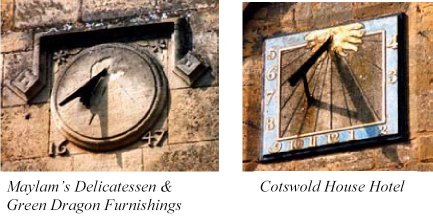 The next dial, walking westward along the High Street, is above a delicatessen,
beside the Market Hall. The rear of the premises houses Green Dragon Furnishings
(6). The house was remodelled in the 18th Century and the 1647 dial seems
to have been done over. The gnomon has been reset quite in the wrong place
so it doesn't even get anywhere near the right time.
The next dial, walking westward along the High Street, is above a delicatessen,
beside the Market Hall. The rear of the premises houses Green Dragon Furnishings
(6). The house was remodelled in the 18th Century and the 1647 dial seems
to have been done over. The gnomon has been reset quite in the wrong place
so it doesn't even get anywhere near the right time.
Further west along the High Street is the Cotswold House Hotel (7). Built
in 1815 by Richard Miles, a grocer and chandler in a fair way of business.
This superb Regency building has featured in a Miss Marple TV series.
There, on an outbuilding, is a delightful dial, We know Richard Miles
paid for it, but who made it and who designed it?
 It might have been Isaac Warner who lived at Dial House (8). A Gloucestershire
clock-making dynasty, Warners moved here in the early 18th Century. Like
most High Street dials their dial doesn't go beyond 3 pm. Further along,
on a house called Green Dragons (9) there is a 1700 dial. The gnomon has
a curl at the end and also has a nodus but again no clue why. A few doors
further west, Crosby House (10) formerly Meadow Cottage, boasts the last
High Street dial, date recorded as 1691.
It might have been Isaac Warner who lived at Dial House (8). A Gloucestershire
clock-making dynasty, Warners moved here in the early 18th Century. Like
most High Street dials their dial doesn't go beyond 3 pm. Further along,
on a house called Green Dragons (9) there is a 1700 dial. The gnomon has
a curl at the end and also has a nodus but again no clue why. A few doors
further west, Crosby House (10) formerly Meadow Cottage, boasts the last
High Street dial, date recorded as 1691.
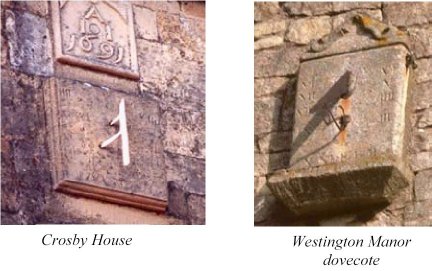 Now walk to Westington, one of Campden's original hamlets; a small manor
house (11) there has a 14th Century dovecote, the interior containing
about 2000 nesting places. The dial is clearly at least a century old
and can be seen by walking up Izod's Close.
Now walk to Westington, one of Campden's original hamlets; a small manor
house (11) there has a 14th Century dovecote, the interior containing
about 2000 nesting places. The dial is clearly at least a century old
and can be seen by walking up Izod's Close.
 Unfortunately the dial on the left above is not visible from anywhere
accessible to the public. Returning to the south side of the High Street,
at the rear of the Old Grammar School (12), rebuilt in 1863 is a dial
high above the playground; now a car park and gardens.
Unfortunately the dial on the left above is not visible from anywhere
accessible to the public. Returning to the south side of the High Street,
at the rear of the Old Grammar School (12), rebuilt in 1863 is a dial
high above the playground; now a car park and gardens.
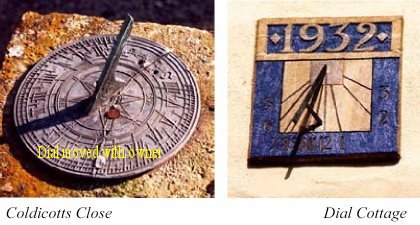 Find Coldicotts Close (13). The dial plate is set correctly but the gnomon
points south! Someone thought it necessary to break the dial plate to
take the gnomon out and turn it round! Out of Campden a little is Blind
Lane and on Dial Cottage (14) built in 1932 for Harold Pyment and then
called Forty Furlong Cottage, is a dial of that date. (Pyment was a follower
of William Morris and the Arts and Crafts Movement, the cottage was in
its true traditions).
Find Coldicotts Close (13). The dial plate is set correctly but the gnomon
points south! Someone thought it necessary to break the dial plate to
take the gnomon out and turn it round! Out of Campden a little is Blind
Lane and on Dial Cottage (14) built in 1932 for Harold Pyment and then
called Forty Furlong Cottage, is a dial of that date. (Pyment was a follower
of William Morris and the Arts and Crafts Movement, the cottage was in
its true traditions).
Finally, Ebrington is a nearby village which has mediaeval to Millennium
dials.
 The
church of St Eadburga has a vertical dial, unusually placed on the chancel
and is nowadays shaded for many of the sunlight hours. Additionally there
are some scratch dials (a) at the east end of the aisle on the south wall,
some distinct, others less so and (b) inside the porch. The
church of St Eadburga has a vertical dial, unusually placed on the chancel
and is nowadays shaded for many of the sunlight hours. Additionally there
are some scratch dials (a) at the east end of the aisle on the south wall,
some distinct, others less so and (b) inside the porch.
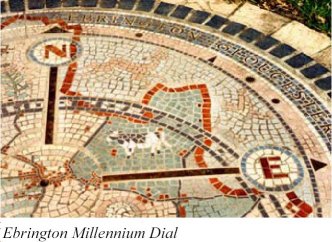 Recently installed by the 'Ebrington Arms' is a 'Millennium Sundial' consisting
of a mosaic dial plate and a 'do-it-yourself' gnomon. (Make sure you take
a walking stick with you!)
Recently installed by the 'Ebrington Arms' is a 'Millennium Sundial' consisting
of a mosaic dial plate and a 'do-it-yourself' gnomon. (Make sure you take
a walking stick with you!)
|
 For
a full overview click here
For
a full overview click here  For
a full overview click here
For
a full overview click here